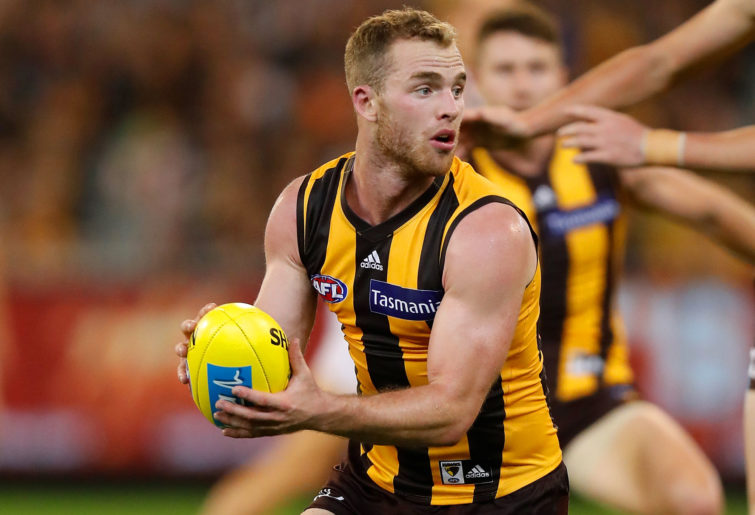Hawthorn’s list profile is about what you’d expect from a team that has been up the top for a long time – they have less youth than most, more veterans than anyone else in the competition, and about the standard number of prime-age players.
Hawthorn’s veterans played 35 per cent of their games this year, and that’s the highest representation for the 28-and-overs of any side in the competition. No other team even cracked the 30 per cent mark, although Geelong came very close.
The Hawks’ vets did meet and beat the expected number of AFLCA votes for this age group across the comp, but not by as large a margin as you would hope for to justify investing so much game time in players who have a limited shelf-life at AFL level.
Those youth and prime-age players who were in the side did solidly well, but one wonders if Hawthorn’s decision to field older players is driven by their quality, or the lack of a depth of it in younger players on the list.
| Hawthorn Hawks list profile |
| Age |
Players |
Games |
% of total |
Votes |
% of total |
| 18-22 |
20 |
123 |
26.62% |
46 |
15.49% |
| 23-27 |
15 |
177 |
38.31% |
158 |
53.20% |
| 28+ |
12 |
162 |
35.06% |
93 |
31.31% |
Under or over?
Hawthorn fielded both the No.1 oldest and No.1 most experienced 22 in the AFL this season, beating out Adelaide and West Coast respectively for those titles.
They were the more experienced side in 18 of 22 matches but remarkably, had an exactly even 50 per cent winning record both as the more experienced team and the less experienced team.
This suggests that, while possessing a wealth of experience, they weren’t really gaining much in the way of a concrete advantage from it.
They only had two matches this year where their side didn’t have an average of at least 100 games experience – a win over North Melbourne in Round 3, and a loss against Geelong in Round 5.
Hawthorn’s EUR this year was 68.4 per cent, the seventh-best in the league, and above the league average, but not by any significant distance.
Verdict: Underperformed. Hawthorn had the oldest and most experienced side in the competition this year, and didn’t get hit any worse by injury than the average side, but couldn’t translate that into an on-field advantage.

(Photo by Quinn Rooney/Getty Images)
Contract watch
Out of contract
Grant Birchall, Shaun Burgoyne, Jon Ceglar, Ollie Hanrahan, Ricky Henderson, Teia Miles, Darren Minchington, David Mirra, Tim Mohr, Marc Pittonet, Paul Puopolo, Ryan Schoenmakers.
Pre-agents
Ben Stratton, Isaac Smith, Kaiden Brand.
The Hawks still have thirteen players out of contract this season, which is more than a quarter of their list. And if that’s not a big enough number for you, they have another 20+ next year!
They’re not inconsequential names, either. A quick glance here shows that the Hawks have tough decisions to make on a number of much-loved players, most notably Grant Birchall and Paul Puopolo.
Birchall I would have to assume will retire after only briefly making it back from injury this year. Puopolo is a harder choice – he played a full 22-game season, but only managed ten goals.
Ricky Henderson is one who it is surprising not to see an extension for yet. Burgoyne we know has a deal in front of him, but is weighing up a three-year offer at the Gold Coast Suns.
Expect the Hawks to lose or move on at least one of Jon Ceglar or Marc Pittonet. Ceglar has been linked to a move to Brisbane and if so you’d expect Pittonet sticks around to be depth if nothing else.
Isaac Smith offers a genuine chance for some pre-agent movement this offseason, having been linked to the Western Bulldogs earlier in the year.
Free agency
A large number of the out of contracts above are free agents, the only two where that’s likely to be of any real consequence are Jon Ceglar and Shaun Burgoyne.
Ceglar, as mentioned, has had that link made to Brisbane, where he would be unlikely to displace Stefan Martin but would probably become Chris Fagan’s go-to option if Stef goes down.
Burgoyne is interesting more for the question of whether or not the Hawks could possibly get a compensation pick for him. He’s the oldest player in the comp, but if he signs a three-year deal on good money, surely they have to get something?
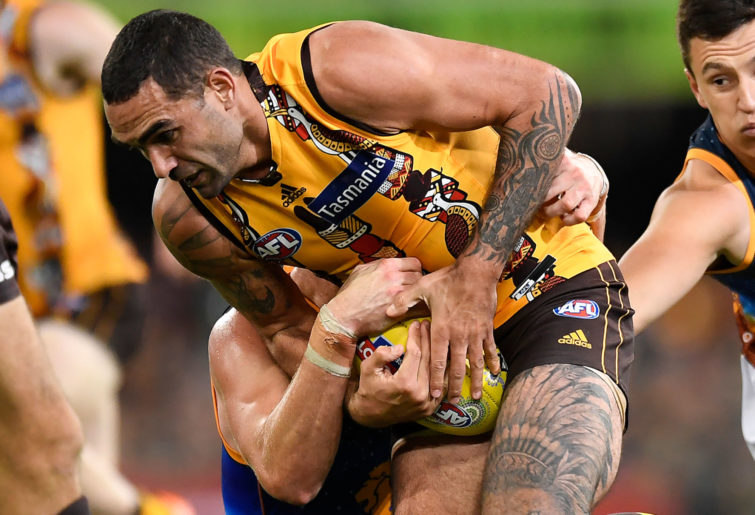
(Photo by Albert Perez/Getty Images)
Paul Puopolo, if he could get an opportunity elsewhere, could move unencumbered as a free agent. I don’t see it happening. Also unlikely but not necessarily impossible is Ryan Schoenmakers finding a new home – he is also a free agent.
Perhaps more curious is Henderson still being on the free agency market. He’ll go close to winning Hawthorn’s best-and-fairest this year so it’s surprising the Hawks haven’t already got him locked in on at least a one-year deal for season 2020.
In terms of free agents coming into the club, we know that Hawthorn were one of the teams most thickly in the race for Stephen Coniglio, and would have been disappointed to hear news that he had re-signed with the Giants last week.
Every club misses players they want at times, but that’s a pretty rare thing to happen to Hawthorn over the last decade – and a phenomenon that we’ll talk more about later on.
Could they pursue another free agent instead? You’d imagine they have decent salary cap space available and if they’re trying to win now – which an old and experienced selection policy suggests – then why not?
Adam Tomlinson and Jamie Elliott are probably the only names of real quality left on the free agency list. Todd Goldstein is there also but doesn’t make much sense for the Hawks, who already have Ben McEvoy in the side.
Elliott would be a surprise to see leave Collingwood, but Tomlinson seems like a strong chance to come back to Victoria this offseason – I wouldn’t be at all surprised to see the Hawks have a serious crack at him.
Trade period
What must it be like to be a Hawthorn supporter? I imagine it’s like being Dudley Dursley at Christmas – knowing that, like clockwork, there’s going to be a fat stack of presents for you at the same time each year.
That’s got to be close to the mark, surely, given that year after year (yes, with some notable exceptions, but not many) Hawthorn have delivered their fans a big-name recruit come October. So who is it in 2019?
Well, this is a difficult one to answer. Obviously their primary goal for most of the season was to bring Stephen Coniglio to the club – something we knew they were working on as far back as 12 months ago.
There are three players they’ve been linked to trading in this offseason, but none of them is of quite the same stature as Coniglio.
The first and best of them is Brad Hill, himself a former Hawk. It’s believed he directly requested a trade to the club last year but was blocked by Fremantle – while the Dockers now appear willing to let him go, Hawthorn seem unlikely to be his destination.
All the latest talk is that Hill will join St Kilda. They’re offering him a $900,000 contract and have pick 5 to dangle in front of the Dockers, so it’s hard to see the Hawks breaking into this one.
They have also been linked to Hugh Greenwood at Adelaide – along with more than a few other clubs, but the Hawks were the first team known to be pursuing him, and so might have an edge.
Personally, I’m sceptical that this is would be a good move for the Hawks. Greenwood’s a solidly good player but a bit limited, and I’m not sure there’s much of a net gain to be made from next year playing him in the same side as Tom Mitchell, Jaeger O’Meara and James Worpel.
Lastly, Jon Patton, who has been secretly wearing a Hawthorn guernsey under his training singlet all season long. He went so far as to knock back the chance to play any NEAFL games, not wanting to risk injury before his move to the Hawks.
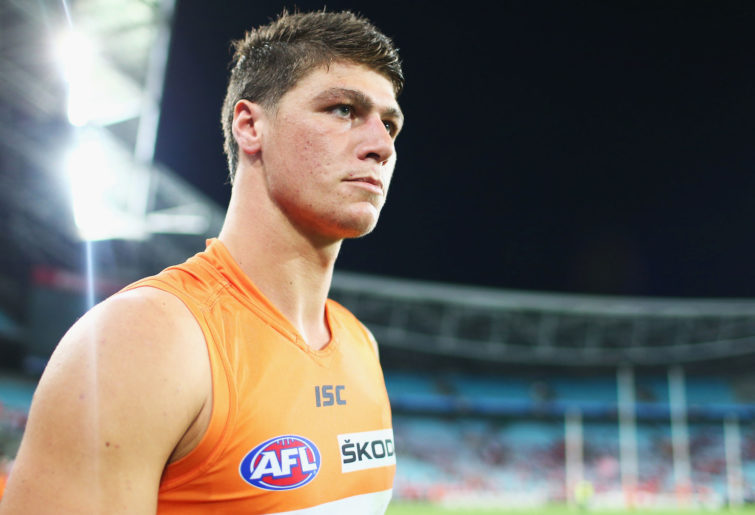
(Photo by Ryan Pierse/Getty Images)
Like Tom Scully the year before, expect the Patton deal to be done for a bargain price. He’s still on a decent-sized contract at GWS next year, and having already found their ideal three-tall forward line, they’ll be happy enough to clear out his salary.
The big question though is whether the Hawks have any tricks up their sleeves, or whether missing out on Coniglio has left them without a card to play.
It is, at the moment, a bit unclear whether they are planning to take the pick 10 they hold to the draft, or use it to trade for more mature talent. I’ve heard both said in the last week, and perhaps there’s some internal debate at the club over the best path to go down.
What has to be recognised here is that Hawthorn are in danger of running afoul of the AFL’s rule that requires clubs to take at least two first-round selections in each four-year period. But, that rule can be waived on special request to the AFL.
A brief aside here: this rule is a flaming heap of garbage. No one appears to understand in any kind of a consistent way how it actually works, and it makes no kind of sense to me to allow clubs to do any myriad number of other stupid things with wanton abandon, but cordon off this one.
Allowing clubs to apply for special consideration only means the restriction is likely to apply to some clubs, not others, and reduces the ability of all 18 clubs to complete trade business on a level playing field.
I say, let clubs trade any and all future selections up to two years in advance and let the cards fall where they may. The smart clubs will thrive and the foolish ones will learn quickly.
Enough on that tangent. Let’s assume the Hawks are looking to sell pick 10 in exchange for a quality player that will come somewhere out of the blue. Who could it be?
For me, Brad Crouch is the name that really stands out here – their decision to target Coniglio suggests they are after another high-quality midfielder, and Crouch is someone who fits that bill that they have also been linked to before, back in 2016.
No deal came about then, but after a frustrating couple of years at the Crows, and finding some real elite form in 2019, could they have the conversation again? If the Hawks pull a trick out from up their sleeves this year, this is the one that jumps out to me as most likely.
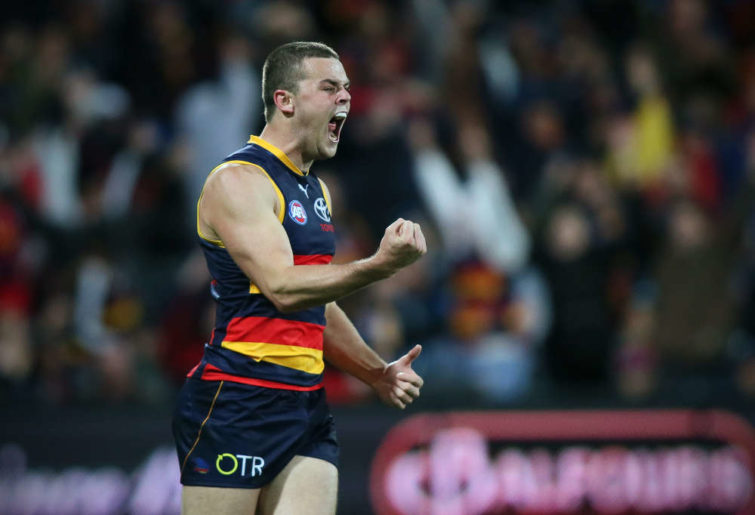
(AAP Image/Ben Macmahon)
There’s a wide variety of less valuable players potentially on move this year also who I’d argue could offer something to Hawthorn. To rattle off a few: Alex Keath, Lewis Taylor, Jayden Laverde, Charlie Constable, Callum Ah Chee, Aiden Bonar, Mason Wood, Karl Amon, Zak Jones.
If the Hawks are intent on trading for mature talent to fill out their list, then the increased levels of movement over the past few years means there will be plenty of players considering their options who could be available to them, and some of them quite cheaply, too.
Could any players leave the club via trade? The only one we’ve heard mention of to this point in the year is Isaac Smith, who very early in the season was linked to the Western Bulldogs, but hasn’t been mentioned much in the time since then.
I would say this one broadly depends on what strategy the Hawks want to go down. If they’re considering going back to the draft and building for the future, there’s an argument for letting Smith go if they feel they can get a reasonable draft pick in return.
If they’re sticking with operation win now, however, I’d say there’s little to no value to be had from trading Smith. Realistically, he will be 31 by the start of next season, and I can’t see him attracting a pick inside the top 30, at which point it’s not really worth it.
Draft
Picks inside 30: 10, 28.
Depending on who you listen to, the Hawks may again this year trade themselves entirely out of the draft, but for discussion’s sake let’s assume they’re taking these picks this year. Who could they look to bring in?
Hawthorn possess little in the way of young talent that you could say is going to comfortably fill a position for the longterm. Off their players 22 and under, only Blake Hardwick and James Worpel were regulars this year.

(Photo by Daniel Kalisz/Getty Images)
Jack Scrimshaw and Mitch Lewis also look like they could be players of the future, and there’s a few othes there who might be come up – but broadly speaking, they’ve got plenty of gaps to fill.
While it’s not a situation any club wants to be in, it does mean that the Hawks have license to draft whichever player they feel is the best talent at their pick, without needing to stress about the position they play in.
Still, the one who jumps out at them for me would have to be Fisher McAsey. He is 195cm key defender, the best tall player in the draft, and would be a logical starting point for building a strong group of youth on the list.
Josh Worrell, also a tall, could come into the mix on the same logic, while Brodie Kemp and Sam Flanders are two I would strongly consider if still on the board here. Dylan Stephens could be in the mix too.
If the Hawks want someone who can make an impact right away, then Will Gould, Deven Robertson or maybe Cody Weightman would be players to consider.
The Hawks have a big-bodied inside midfielder in Finn Maginness, son of Scott, who will join the club this year as a father-son prospect.
Expect a bid for him to come sometime between their first and second selections, with the second to be swallowed up by that – unless they do some canny trading around it, which wouldn’t surprise.
What I said last year
“The Hawks haven’t rebuilt, they’ve simply had surgery. Rather than organically growing their own seed talent, they’ve nicked cuttings from their neighbours’ gardens…
“The Hawks, along with Geelong, have been Victoria’s big glamour club for near on a decade now and if someone wants a trade to Victoria the Hawks have generally had first right of refusal.
“Maybe that’s about to change… Or maybe it isn’t. Maybe Hawthorn will still continue to be the preferred destination of ex-pat Victorians coming home, and the Tom Lynch decision will prove to be nothing more than a blip on the radar…
“I suspect the Hawks can continue their strategy of bringing in high-quality mature talent from other clubs and supplementing it with lower draft picks more or less indefinitely.
“This will prove to be particularly successful if the Hawks can mostly bring in talent through free agency, as they appear to be aiming to do next year, allowing them to keep their first-round draft picks.”
Outlook
I’m a little less optimistic on the Hawks in 2019 than I was last year. At the time that was written, they seemed to be the front runners for Dylan Shiel, and it also looked like a strong possibility they’d be picking him up as a free agent this year, rather than via trade.
Of course as we know, that didn’t happen. Essendon pipped Hawthorn as the more appealing destination for Shiel’s services, and that’s become something of a trend over the last two years: they’ve targetted Tom Lynch, Shiel and Stephen Coniglio, all without getting them.
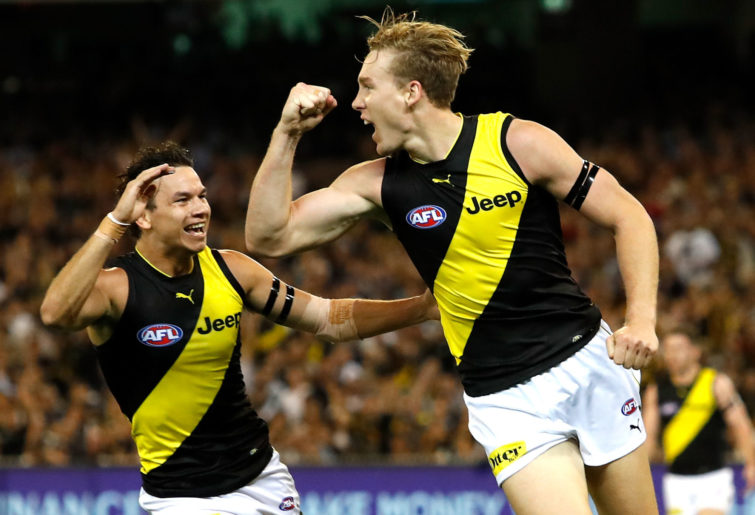
(Photo by Dylan Burns/AFL Photos/Getty Images)
Now, Hawthorn being Hawthorn, they were able to say ‘oh well’, move on, and go get Chad Wingard and Tom Scully instead. A pretty damned good pair of back-up options, if you ask me!
But the Hawks no longer being the first choice option for Victorians coming home is a subtle but important change in the footy landscape, and one that will undermine their ability to execute a trade-focused list strategy.
If you flash back to the list building that delivered their golden 2013-15 era – yes, it was aided by a lot of trading, but it was underpinned by a core of elite talent they pick up from drafts in the early 2000s.
From 2001 through 2004 they drafted Luke Hodge, Sam Mitchell, Jarryd Roughead, Lance Franklin, Jordan Lewis and Brad Sewell.
These players formed the bedrock of that Hawthorn side, defined how the club played and were its best players – they could not have had the same success without them.
The Hawks were able to construct a multi-premiership list through a mix of well-targetted trading and a few other good-quality draft picks along the way, but they needed this period of time where they made a strong investment in the draft to be the foundation of that.
What they’ve done over the last four years is instead a totally different experiment – they’re trying to make trade-ins the foundation of a new premiership side, and I’m not sure it can be done. The players they’ve brought in are already partway through their careers, and have cost them a lot, leaving them with little time or currency to build quality depth around them.
For mine, they have two paths to go down – one is to double-down on this strategy and give it the best crack they can, knowing that success is unlikely but they may just be maverick enough to pull it off. The other would be to acknowledge that it hasn’t really worked for them, and try to get started on a rebuild as soon as possible.
You can sum up the state of their youth in a single tweet:
Look at these lads. If you could pick them out of a lineup then you are probably part of Hawthorn’s coaching staff, and honestly even if you are but still wouldn’t recognise them walking down the street, I wouldn’t blame you.
Back in my days working at a bottle-o, they would’ve all gotten a very sceptical look at the driver’s license.
Their 22-and-under brigade is so sparse in terms of bluechip talent that even hitting the draft now is not going to prevent what looks like an inevitable nosedive.
So, the question then becomes, is it better to mitigate that as much as possible, or should the club make the best attempt it can to win another flag now and deal with the consequences later?
I believe there’s a solid argument for the latter. Chad Wingard and Tom Scully will both be better players next year after another preseason at Hawthorn, and they’ll get a Brownlow Medallist in Tom Mitchell back too.
Jon Patton could provide them with a genuine target up forward that makes the job easier for everyone else up there too.
And that alone is without considering who they might be able to bring in with pick 10 this year. If they land another A-grade talent like Brad Crouch – or who knows who else they might be talking to – then it’s not at all unrealistic to target another top-four finish.
A common criticism of media discussion around Hawthorn this year was that whenever the Hawks had a good win, Clarko was lauded for it more so than the players, so enamoured are we with his evident coaching genius.
While that’s a fair criticism to make… it’s kind of true, isn’t it? This isn’t a list strategy that I would recommend for any other club in the competition, but with Clarko manning the whiteboard at Hawthorn you feel like anything’s possible.
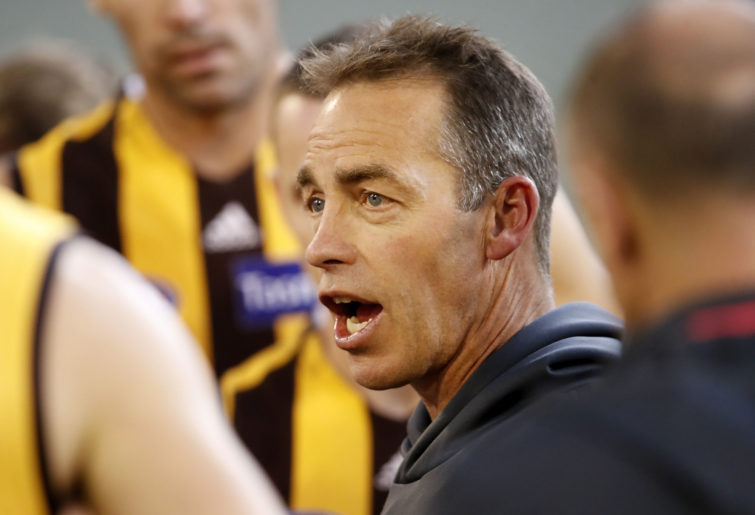
(Dylan Burns/AFL Photos)
Clarkson, I suspect, will be keenly aware of two things.
The first is that the competition is kind of weak right now. There are no dominant dynasty teams like we’ve seen for much of the millenium so far. A side that would’ve been considered ‘above average’ five or ten years ago is considered a premiership contender now – so you don’t need to have all that many nice pieces together to be a threat.
The second is that he has a contract with Hawthorn for the next three years. And I would suggest that for Clarko, and for Hawthorn, this should be the strategy deadline – go hard at trying to scrape together a flag side in this little window, and then pivot to the draft thereafter, whether that’s under a new coach or not.
Thanks to Stats Insider, the AFL Coaches Association, and Draftguru for providing data and tools to make the analysis in this article possible.






























































































